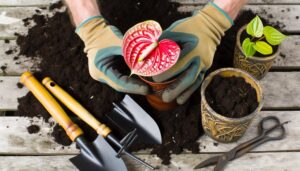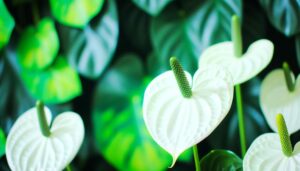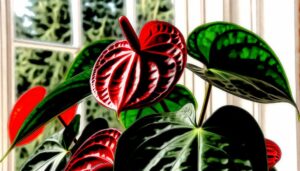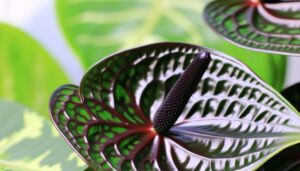Caring for Your Black Garuda Anthurium
To care for your Black Garuda Anthurium, place it in bright, indirect light near east or north-facing windows. Keep the temperature between 65-80°F and humidity above 60%.
Water when the top inch of soil is dry, ensuring proper drainage to avoid root rot. Use a soil mix of orchid bark, perlite, and peat moss, maintaining a pH between 5.5 and 6.5.
Regularly mist leaves and use a humidifier to maintain humidity. Prune dead leaves and watch for pests like aphids and spider mites.
Adjust care seasonally to maintain plant health. For deeper insights into each care aspect, continue exploring.
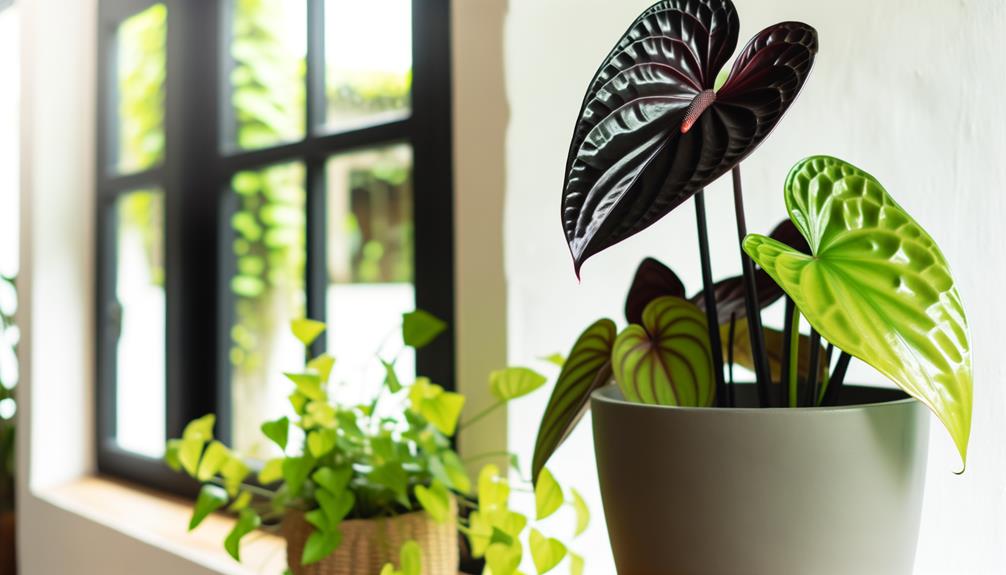
Key Takeaways
- Maintain bright, indirect light and avoid direct sunlight to prevent leaf burn.
- Water when the top inch of soil is dry, ensuring proper drainage to prevent root rot.
- Keep humidity between 70%-80%, using a humidifier or misting leaves regularly.
- Prune dead leaves and leggy stems to encourage new growth, using sterilized tools.
- Inspect regularly for pests and use appropriate treatments to maintain plant health.
Choosing the Right Location
Selecting the best location for your Black Garuda Anthurium involves considering factors such as light intensity, humidity levels, and temperature consistency.
You need to place it where it won't experience significant temperature fluctuations. Aim for a stable range between 65°F and 80°F.
To mimic its natural tropical habitat, ensure a humidity level of at least 60%. If your home is particularly dry, consider using a humidity tray or a humidifier.
Avoid placing it near vents or drafty windows, as sudden changes can stress the plant. It's essential to maintain a consistently warm and humid environment to encourage healthy growth.
Positioning it correctly will help your Black Garuda Anthurium thrive, showcasing its unique and stunning foliage.
Ideal Lighting Conditions
Securing optimal lighting for your Black Garuda Anthurium involves providing bright, indirect light to prevent scorching its delicate leaves. Position it near an east or north-facing window where it can benefit from morning light and shaded afternoon conditions. Direct sunlight can cause leaf burn, so consider using sheer curtains to scatter intense rays.
If natural light is insufficient, supplement with fluorescent grow lights positioned about 12 inches above the plant. Strive for 10-12 hours of light daily to replicate its tropical habitat. Rotate the plant periodically to guarantee even light distribution, fostering balanced growth.
Avoid placing your Anthurium in poorly lit corners, as inadequate light can result in spindly growth and decreased blooming. This meticulous care ensures a thriving, healthy plant.
Watering Guidelines
When caring for your Black Garuda Anthurium, you need to focus on maintaining best watering frequency and soil moisture levels. Water your plant when the top inch of soil feels dry to the touch, ensuring the soil remains consistently moist but never waterlogged.
Overwatering can lead to root rot, so it's important to allow excess water to drain thoroughly.
Optimal Watering Frequency
To maintain the health of your Black Garuda Anthurium, water it thoroughly once the top inch of soil feels dry to the touch. This guarantees that the plant receives sufficient moisture without becoming waterlogged.
Follow these steps for ideal watering frequency:
- Check Soil Regularly: Use your finger to test the top inch of soil every few days.
- Water Evenly: Make sure water spreads evenly across the soil surface to avoid dry spots.
- Drain Excess Water: Ensure the pot has drainage holes to prevent root rot.
- Adjust Seasonally: During winter, reduce watering frequency since the plant's growth slows.
Soil Moisture Levels
Maintaining appropriate soil moisture levels is crucial for the health and well-being of your Black Garuda Anthurium. You should consistently keep the soil evenly damp but not waterlogged. Overwatering can lead to root rot, while underwatering can stress the plant. Use a moisture meter to ensure ideal levels. Aim for soil that's damp to the touch, but not saturated, to provide perfect conditions.
```markdown
| Moisture Level | Action Required |
|---|---|
| Dry | Water immediately |
| Slightly damp | Monitor daily |
| Damp | Maintain current level |
| Wet | Allow to dry slightly |
| Soggy | Reduce watering |
```
Check the soil moisture level every few days and adjust your watering routine accordingly. Remember, consistent care will help your Black Garuda Anthurium thrive.
Humidity Requirements
Your Black Garuda Anthurium thrives best in environments with consistent high moisture levels, ideally between 70% and 80%. Maintaining this moisture can be challenging, but it's vital for the plant's lush, vibrant foliage.
Here are four tips to help you achieve the perfect moisture:
- Humidifier: Place a humidifier near your plant to guarantee a steady moisture level.
- Pebble Tray: Set your plant pot on a tray filled with water and pebbles to increase ambient dampness.
- Misting: Regularly mist the leaves with distilled water to mimic the plant's natural habitat.
- Grouping Plants: Group your anthurium with other moisture-loving plants to create a microenvironment that retains dampness.
Soil Preferences
For best growth, your Black Garuda Anthurium requires a soil mix that guarantees proper drainage and aeration. You'll want to use a combination of orchid bark, perlite, and peat moss to achieve the ideal composition.
Maintaining a slightly acidic pH level between 5.5 and 6.5 will also support the plant's nutrient uptake and overall health.
Ideal Soil Composition
Given its tropical origins, the Black Garuda Anthurium thrives best in a well-draining, airy soil mix rich in organic matter. To achieve this, you'll need to create a balanced blend that mimics its native environment.
Here are the key components:
- Orchid Bark: Secures excellent drainage and aeration, preventing root rot.
- Coconut Coir: Retains moisture without becoming soggy, providing a stable growing medium.
- Perlite: Adds porosity to the mix, enhancing air flow around the roots.
- Composted Pine Bark: Offers organic nutrients and improves the soil structure.
Drainage and Aeration Needs
Securing proper drainage and aeration is crucial to preventing root rot and encouraging healthy root development in your Black Garuda Anthurium.
Choose a well-draining potting mix, combining equal parts of orchid bark, perlite, and peat moss. This combination guarantees moisture retention without waterlogging. Integrate charcoal pieces to boost aeration.
Select pots with drainage holes to facilitate easy escape of excess water. Raise the pot slightly using a saucer or pot feet to further enhance airflow to the roots.
Routinely assess the soil's moisture level by inserting your finger an inch deep; it should feel slightly damp. By carefully managing drainage and aeration, you'll cultivate a thriving environment for your Black Garuda Anthurium.
Ph Level Requirements
To thrive, Black Garuda Anthurium requires soil with a pH level between 5.5 and 6.5, slightly on the acidic side. Ensuring the right pH balance is essential for nutrient absorption and overall plant health.
You can maintain this balance by carefully selecting your soil mix and regularly testing its pH.
Here's how you can achieve the best soil conditions:
- Use peat-based soil mix: Peat moss naturally maintains an acidic pH.
- Add pine bark: This helps lower the pH and improves aeration.
- Incorporate perlite: Enhances drainage while keeping the soil light.
- Test soil pH monthly: Use a reliable pH meter to monitor and adjust as needed.
Following these guidelines will keep your Black Garuda Anthurium flourishing.
Fertilizing Schedule
You'll need to fertilize your Black Garuda Anthurium every four to six weeks using a balanced, water-soluble fertilizer diluted to half strength. First, ensure the soil is moist before applying the fertilizer to prevent root burn.
Mix the fertilizer at a ratio of 1:1:1 (N-P-K) and dilute it to 50% of the recommended dosage. Pour the solution evenly around the base of the plant, avoiding direct contact with the leaves.
During the growing season, you might notice increased foliage and flower development. However, reduce fertilization to every eight weeks during the plant's dormant period in winter.
Monitor the plant's response and adjust the frequency if you observe signs of nutrient deficiency or excess.
Pruning Techniques
When pruning your Black Garuda Anthurium, focus on removing dead leaves to prevent disease and improve plant health. Use clean, sharp scissors to make precise cuts at the base of the affected leaves.
This practice also encourages new growth, promoting a fuller and more vibrant plant.
Removing Dead Leaves
Pruning dead leaves from your Black Garuda Anthurium is essential for maintaining the plant's overall health and aesthetic appeal. Start by inspecting your plant regularly for any brown, wilted, or yellowing leaves.
When you spot them, use sterilized pruning shears to make clean cuts close to the base of the stem. This reduces the risk of disease and encourages the plant's energy to focus on healthy growth.
Follow these steps:
- Identify dead leaves: Look for discoloration or wilted texture.
- Sterilize your tools: Use rubbing alcohol or a bleach solution.
- Cut near the base: Make precise cuts close to the stem without damaging it.
- Dispose properly: Remove the pruned leaves to prevent disease spread.
Encouraging New Growth
To encourage new growth in your Black Garuda Anthurium, carefully prune the plant by trimming back any leggy stems and overgrown areas. Use sharp, sterilized pruning shears for clean cuts. Focus on removing stems that are thin or weak, as these can sap energy from the healthier parts of the plant. Make cuts just above a node to stimulate new growth.
Here's a quick guide to help:
| Action | Description |
|---|---|
| Prune Leggy Stems | Trim back to a healthy node |
| Remove Weak Stems | Cut off thin or weak stems |
| Sterilize Shears | Use alcohol or hot water to clean pruning tools |
| Monitor Growth | Regularly check for new growth and prune as necessary |
Repotting Instructions
Repotting your Black Garuda Anthurium involves carefully transferring the plant to a slightly larger container, ensuring best root health and continued growth. To start, select a pot that's 1-2 inches wider than the current one. It's important to use a well-draining soil mix, ideally one containing orchid bark, perlite, and peat moss.
Follow these steps:
- Preparation: Water the plant a day before to ease removal.
- Removal: Gently remove the plant, teasing out the roots without damaging them.
- New Pot: Place a layer of fresh soil at the bottom of the new pot.
- Transplant: Position the Anthurium in the center and fill around the roots with soil, firming it gently.
This process will promote healthier growth and more vibrant foliage.
Pest Control
While caring for your Black Garuda Anthurium, you'll need to be watchful about common pests like aphids, spider mites, and mealybugs that can compromise the plant's health.
Inspect your plant regularly by examining the undersides of leaves and stems. If you spot pests, act promptly. For aphids, a strong spray of water can dislodge them. Spider mites can be managed with a miticide or insecticidal soap. Mealybugs require a more thorough approach; dab them with a cotton swab dipped in rubbing alcohol.
Ensure good air circulation to deter these pests. Use neem oil as a preventive measure, applying it every two weeks. Consistent monitoring and prompt action will keep your Black Garuda Anthurium thriving.
Disease Prevention
Ensuring disease prevention in your Black Garuda Anthurium requires diligent practices such as proper watering techniques, sterilizing tools, and maintaining ideal humidity levels.
Follow these steps to keep your plant healthy:
- Watering: Water your Anthurium when the top inch of soil is dry. Overwatering can lead to root rot.
- Sterilizing Tools: Always sterilize your pruning tools with rubbing alcohol before use to prevent the spread of pathogens.
- Humidity: Maintain a humidity level of 60-80%. Use a humidifier or a pebble tray to keep the air moist.
- Monitoring: Regularly check for any signs of disease, such as yellowing leaves or mold, and address issues promptly.
Temperature Needs
To keep your Black Garuda Anthurium thriving, maintain a consistent temperature between 65-80°F (18-27°C). This specific range ensures ideal growth and helps prevent temperature-induced stress.
Avoid sudden temperature fluctuations; your plant doesn't appreciate drafts or sudden changes. Place it away from heating vents, air conditioners, and frequently opened windows or doors.
Monitoring indoor temperatures with a reliable thermometer is essential. If temperatures fall below 65°F, the Anthurium may experience stunted growth or leaf discoloration. Conversely, temperatures above 80°F can lead to dehydration and wilting.
During colder months, consider using a room heater to maintain warmth. By carefully regulating temperature, you'll create an environment where your Black Garuda Anthurium can thrive effortlessly.
Seasonal Care Tips
Adjust your care routine seasonally to maintain your Black Garuda Anthurium remains healthy throughout the year.
Each season brings unique challenges and opportunities for your plant's well-being.
- Spring: Increase watering frequency as growth accelerates. Check for new growth and modify nutrient supply.
- Summer: Maintain consistent humidity, at least 60%, and provide indirect sunlight. Watch for pests that thrive in warm conditions.
- Fall: Gradually reduce watering and feeding as the plant's growth slows. Monitor for leaf drop and adapt care as needed.
- Winter: Sustain a stable temperature, ideally between 65-75°F. Use a humidifier to combat dry indoor air, and guarantee the plant receives adequate light.
Conclusion
Caring for your Black Garuda Anthurium guarantees it thrives and adds beauty to your space.
Imagine Jane, who diligently followed these guidelines, placing her plant in indirect light, maintaining 60% humidity, and using well-draining soil. Her Anthurium flourished, becoming the centerpiece of her room.
By adhering to these practices—optimal lighting, proper watering, and pest control—you'll see similar success.
Remember, attention to detail is key; your Anthurium's health depends on it.



